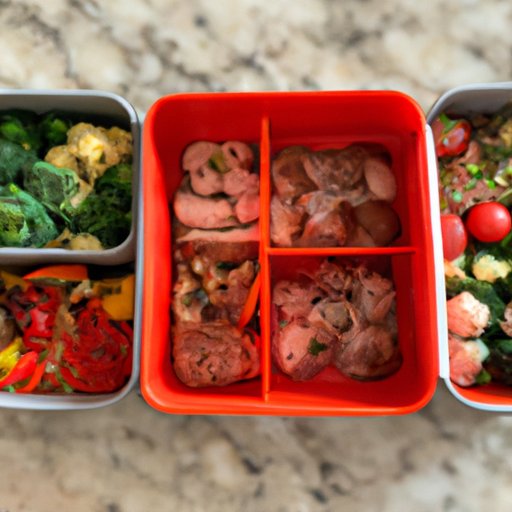Introduction
When it comes to improving your health, there’s no better way to start than by changing what you eat. Eating healthy can help boost your energy levels, improve your mental clarity, and even reduce your risk of developing certain diseases. However, many people don’t know where to start when it comes to making healthy eating a priority. This article will provide helpful tips on how to make healthy eating easier, including meal prep ideas, budget-friendly strategies, plant-based recipes and more.

Meal Prep Ideas for Healthy Eating
Meal prepping is the practice of preparing meals in advance, typically for an entire week at a time. It allows you to plan out nutritious meals, save time and money, and keep up with your healthy eating goals. Here are some tips to make meal prepping easier:
- Start small. Don’t try to do too much too soon. Start by prepping one meal per day, then gradually increase as you get used to the process.
- Plan ahead. Decide what meals you’d like to prepare for the week, then make a list of the ingredients you’ll need to buy.
- Make a schedule. Set aside a specific time each week to cook and prep your meals.
- Store properly. Store prepped food in airtight containers in the fridge or freezer to keep them fresh.
The benefits of meal prepping are numerous. According to a study published in the Nutrition Journal, meal prepping can lead to improved dietary quality and help individuals stick to their nutrition goals. It can also help reduce food waste since you’re only buying and cooking what you need.

Eating Healthy on a Budget
Eating healthy doesn’t have to be expensive. There are several strategies you can use to eat healthy on a budget, such as:
- Shop at farmer’s markets. Buying directly from local farmers can help you save money on high-quality produce.
- Buy in bulk. Purchasing items like grains, nuts, seeds, and spices in bulk can help you save money.
- Choose frozen produce. Frozen fruits and vegetables are just as nutritious as their fresh counterparts, but they’re often cheaper.
- Grow your own food. Gardening is a great way to save money while getting fresh, organic produce.
You can also save money by shopping smart. According to a study published in the Journal of Nutrition Education and Behavior, grocery shopping strategies like creating a grocery list, avoiding impulse buys, and shopping the perimeter of the store can help you save money while still eating healthy.
Tips to Eat Healthier
Eating healthy isn’t just about what you eat; it’s also about how you eat. Here are some tips to help you make healthier food choices:
- Choose whole foods. Opt for foods that are minimally processed and free of added sugars, sodium, and unhealthy fats.
- Watch your portion sizes. Pay attention to serving sizes and avoid overeating.
- Balance your diet. Make sure to include a variety of healthy foods from all the food groups.
These simple tips can help you make healthier food choices and achieve your nutrition goals.
Plant-Based Diet Recipes
Switching to a plant-based diet is one of the best ways to eat healthy. Plant-based diets are rich in fiber, vitamins, minerals, and antioxidants, which can help protect against chronic diseases. Here are some tips for incorporating more plant-based foods into your diet:
- Start small. Try going meatless one day a week or opting for plant-based proteins instead of animal proteins.
- Experiment with recipes. Look for easy, delicious plant-based recipes to try out.
- Substitute meat. You can easily substitute meat for plant-based proteins like beans, lentils, tofu, and tempeh.
There are plenty of tasty plant-based recipes out there, so don’t be afraid to experiment and find new favorites!
Superfoods Shopping Guide
Superfoods are nutrient-rich foods that are packed with vitamins, minerals, and antioxidants. Incorporating them into your diet can help you get all the essential nutrients your body needs. Here’s a quick guide to shopping for superfoods:
- Know what to look for. Common superfoods include dark leafy greens, berries, nuts and seeds, and legumes.
- Shop around. Superfoods can be found in most grocery stores, but you can also find them in specialty stores and online.
- Be creative. Incorporate superfoods into your meals by adding them to salads, smoothies, and other dishes.
Adding superfoods to your diet can help you get important nutrients and support your overall health.
Best Snacks for Healthy Eating
Snacking can be part of a healthy diet, as long as you choose wisely. Here are some tips for finding healthy snacks:
- Check the nutrition facts. Look for snacks that are low in sugar and saturated fat and high in fiber and protein.
- Go for whole foods. Choose snacks like fruit, veggies, nuts, and yogurt instead of processed snacks.
- Get creative. Make your own healthy snacks like trail mix, homemade granola bars, and veggie chips.
By making smart snack choices, you can satisfy your cravings without compromising your health.
Conclusion
Eating healthy doesn’t have to be complicated or expensive. With the right strategies and tools, you can easily incorporate nutritious meals, snacks, and superfoods into your diet. Meal prepping, shopping on a budget, and choosing healthier food options can help you make healthy eating a priority.
(Note: Is this article not meeting your expectations? Do you have knowledge or insights to share? Unlock new opportunities and expand your reach by joining our authors team. Click Registration to join us and share your expertise with our readers.)
